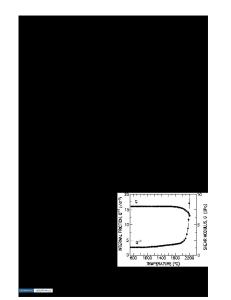Metallic surface layers deposited by diffusional creep during internal oxidation
- PDF / 990,955 Bytes
- 4 Pages / 594 x 774 pts Page_size
- 69 Downloads / 323 Views
746--VOLUME 17A, APRIL 1986
below the limited range, the matrix toughness is lowered to a level at which the matrix can activate the intralath carbides as well as the interlath carbides. Thus, TME cannot occur due to the relative insensitivity of matrix to the microstructural change with tempering. Of course, no occurrence of TME may be because of the decreased low temperature intrinsic toughness of matrix itself, regardless of carbides. At present, since the mechanisms of transgranular cleavage fracture in martensitic steels which have the complicated microstructure have not been clarified, the interaction between matrix and carbides may be a difficult problem. At test temperatures above that range, the matrix toughness is increased up to a level at which the transgranular brittle fracture cannot take place but the transgranular ductile fracture can occur. Thus, the transgranular brittle type of TME cannot be observed above that range. Therefore, it is believed that a fundamental reason that the intergranular and transgranular brittle types of TME occur in the Ni-steel and the Mo- and W-steels, respectively, is the difference in intrinsic matrix toughness with alloying additions. REFERENCES 1. S.K. Banerji, C. J. McMahon, Jr., and H. C. Feng: Metall. Trans. A, 1978, vol. 9A, pp. 237-47. 2. C.L. Briant and S.K. Banerji: Metall. Trans. A, 1979, vol. 10A, pp. 1151-55. 3. C.L. Briant and S.K. Banerji: Metall. Trans. A, 1979, vol. 10A, pp. 1729-37. 4. N. Bandyopadhyay and C. J. McMahon, Jr.: Metall. Trans. A, 1983, vol. 14A, pp. 1313-25. 5. G. Thomas: Metall. Trans. A, 1978, vol. 9A, pp. 439-50. 6. J.E. King, R. F. Smith, and J. E Knott: Proc. Fourth Int. Conf. on Fracture, D. M. R. Taplin, ed., Univ. of Waterloo Press, Waterloo, 1977, vol. 2, p. 279. 7. H. K. D. H. Bhadeshia and D. V. Edmonds: Metal Sci., 1979, vol. 13, pp. 325-34. 8. T. M. E Ronald: Metall. Trans., 1970, vol. 1, pp. 2583-92. 9. F. Zia-Ebrahimi and G. Krauss: Acta Metall., 1984, vol. 32, pp. 1767-77. 10. H. Kwon and C. H. Kim: J. Mater. Sci., 1983, vol. 18, pp. 3671-78. I1. H. Kwon and C . H . Kim: Metall. Trans. A, 1984, vol. 15A, pp. 393-95. 12. H. Kwon and C . H . Kim: Metall. Trans. A, 1983, vol. 14A, pp. 1389-94.
Metallic Surface Layers Deposited by Diffusional Creep during Internal Oxidation J. RODWAY MACKERT, Jr. When internal oxidation of various alloys is carried out under conditions which prevent simultaneous external oxidation, metallic nodules or surface layers are sometimes observed to form. A diffusional creep mechanism for the J. RODWAY MACKERT, Jr. is Associate Professor, Division of Dental Materials, School of Dentistry, Medical College of Georgia, Augusta, GA 30912. Manuscript submitted June 24, 1985.
METALLURGICAL TRANSACTIONS A
formation of these nodules and surface layers on palladiumsilver-based alloys was recently described. ~The purpose of this paper is to summarize the diffusional creep mechanism for the formation of metallic nodules and surface layers during internal oxidation and to describe several instances from the l
Data Loading...











